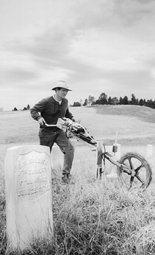


High tech devices used in environmental cleanup work were borrowed by the U.S. National Park Service to find the remains of 28 missing troopers from Company E, 7th Cavalry, killed at the Little Bighorn Battlefield in Montana.
The Park Service used the equipment in an area of the battlefield known as Deep Ravine, where it is thought that the last of Lt. Col. George Armstrong Custer's company was killed during the fight with some 1,500 Teton Sioux and Northern Cheyenne in June 1876. The technologies offered a way to look below the surface of the ground for evidence of the soldiers' burial site without disturbing the vegetation and soil. Data readouts were sent to the Park Service for interpretation. Some of the equipment may be brought back for a second survey later this year.
 One of the technologies employed was the Rapid Geophysical Surveyor originally developed at Idaho National Engineering Laboratory and licensed to a spinoff company, Sage Earth Science of Idaho Falls, Idaho. The RGS, originally designed to locate buried waste, was used to help locate metal objects such as soldier uniform buttons and other accessories that possibly mark the grave site of the men.
One of the technologies employed was the Rapid Geophysical Surveyor originally developed at Idaho National Engineering Laboratory and licensed to a spinoff company, Sage Earth Science of Idaho Falls, Idaho. The RGS, originally designed to locate buried waste, was used to help locate metal objects such as soldier uniform buttons and other accessories that possibly mark the grave site of the men.
A second device was the Ground Penetrating Radar Imaging System developed by Coleman Energy and Environmental Systems, Orlando, Florida. Engineers used the system to look for geological structures and layering in the subsoil that would indicate the possibility of a grave site. Various studies on the Coleman technology's application in environmental cleanup were also funded by DOE.
The project was the combined effort of DOE, the Park Service, and MAC Technical Services Company, Idaho Falls, which brought the technologies together. The DOE technologies were developed through the Office of Technology Development's landfill stabilization focus area and are intended to reduce costs and risk for DOE environmental cleanup work.
The missing remains of the 28 soldiers has been one of the more intriguing puzzles surrounding the Battle of Little Bighorn. Custer and 210 of his men were killed in the battle; however, historians say 28 soldiers were killed in Deep Ravine, away from the main group of men. Historians believe that several days after the battle, a burial party arrived at the ravine without the tools to give the fallen soldiers a proper burial, so the dead were barely covered with dirt and sagebrush. When others returned a year later to improve the graves, the remains of nearly all the men were found except for those believed to have been killed in Deep Ravine. Archeologists speculate that heavy rains washed sediments down the ravine, deeply burying the bodies. Several hundred random core samples were taken in 1985 in a vain attempt to find bone fragments and personal articles.
Dough McChristian, an historian with the Park Service, said information produced using the environmental cleanup devices would "verify the historical Indian accounts that this location was the real 'last stand,' because the last soldiers alive were in that part of the battlefield. It could help piece together the puzzle of how the battle occurred."